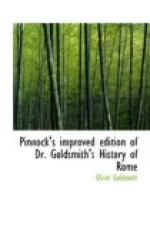[20] He is by some called Am’pronus.
[21] His mother Anto’nia, used to call him a human monster; and his nephew, Calig’ula, when he had butchered many of his kindred, saved him merely for a laughing-stock. The kindest word Agustus gave him was that of Misel’lus, (poor wretch.) This example was followed by others. If he happened to come to table when the guests had taken their places, no one showed him the least civility; and when he slept, as he sometimes did, after meals, they would divert themselves by throwing the stones of fruit at him, or by wakening him with a blow of a rod or whip.
[22] Her’od Agrip’pa was the grandson of Herod the Great; who, at the birth of our Saviour, caused all the infants of Bethlehem to be massacred, in hopes that he would fall in the number. Her’od Agrip’pa to please the Jews, also persecuted the Christians; and put to death St. James the Great.
[23] He put to death Cher’ea and some others of the murderers of his nephew.
[24] Sen’eca, a celebrated philosopher, and a son of Sen’eca the orator, was born at Corduba, in Spain, A.D. 8. This town was also the birthplace of his father. (Strabo and Lucan.) Corduba was founded by the Romans, B.C. 150, and in process of time it became the residence of the Moorish kings, and where they continued till their expulsion into Africa. It was in the vicinity of this city that Caesar fought his last battle with the sons of Pompey.
[25] Vespasian was at that time conducting the war in Jude’a, in Asia.
[26] The destruction of Jerusalem happened in the year of our Lord 70.
[27] Hercula’neum, Pompe’ii, &c. This eruption happened August 24, A.D. 79. These towns, after having been buried under the lava for more than 1600 years, were discovered in the beginning of the last century: Hercula’neum, in 1713, about 24 feet under ground, by labourers digging a well, and Pompe’ii 40 years after, about 12 feet below the surface; and from the houses and streets which, in a great measure, remain perfect, have been drawn busts, statues, manuscripts, paintings, &c. which contribute much to enlarge our notions concerning the ancients, and develope many classical obscurities. (Mala.) In the year following this dreadful eruption, a fire happened at Rome, which consumed the capitol, the pantheon, the library of Augustus, the theatre of Pompey, and a great many other buildings. In the ruins of Hercula’neum there have lately been found loaves which were baked under the reign of Titus, and which still bear the baker’s mark, indicating the quality of the flour, which was probably prescribed by the regulation of the police. There have also been found utensils of bronze, which, instead of being tinned, like ours, are all silvered; the ancients doubtless preferred this method, as more wholesome and more durable. The excavations at Pompe’ii continue to furnish the royal museum at Naples with all kinds of valuable objects: some buildings have lately been discovered at Pompe’ii, remarkable for the richness of their architecture. At Paggo’ia, another town buried by the lava from Vesuvius, some sepulchres have been found, which are stated to be magnificently adorned with sculpture of the finest kind.




